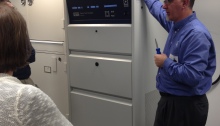Color by Numbers, Part 1: Spectrophotometry vs. Colorimetry
In our lightfastness testing of metal-complex solvent dye solutions, we see some samples that fade a lot and are very easy to qualify as “fast-fading” dyes. (See our previous post for more information on metal-complex solvent dyes and why we’re using them; as well as previous posts that detail our sample set and sample preparation)…






